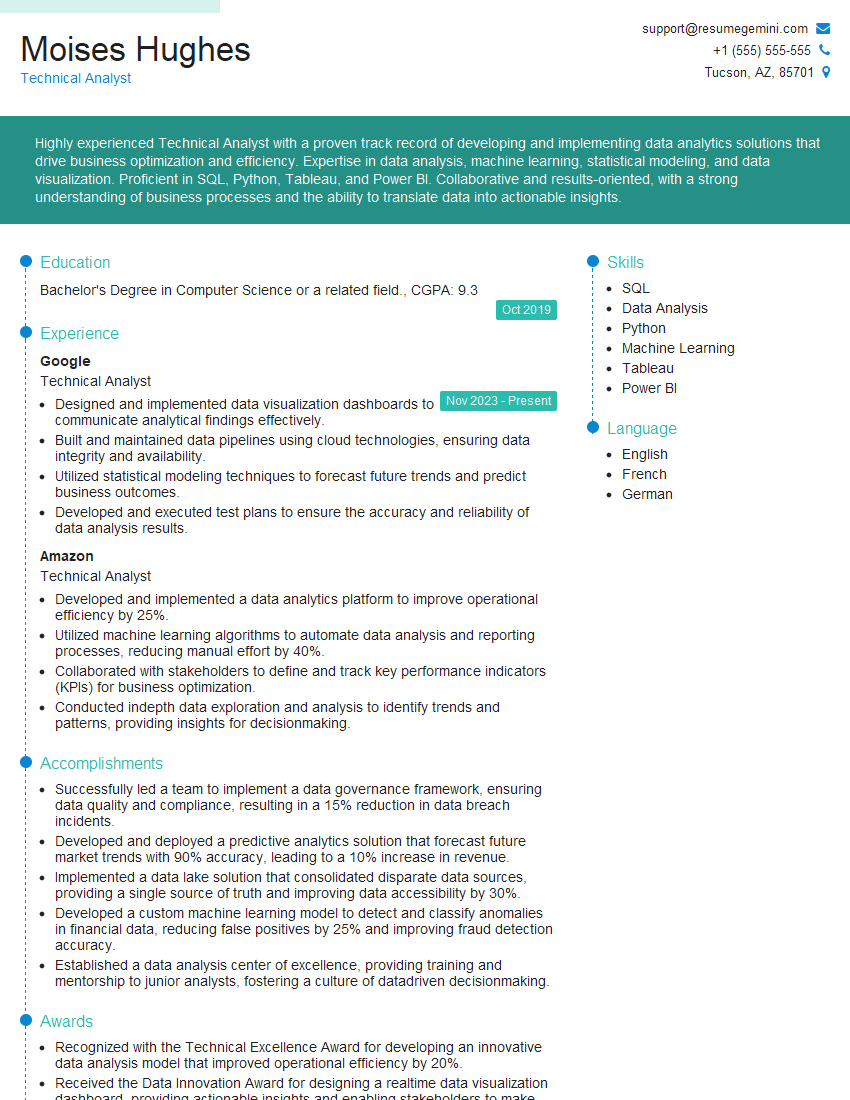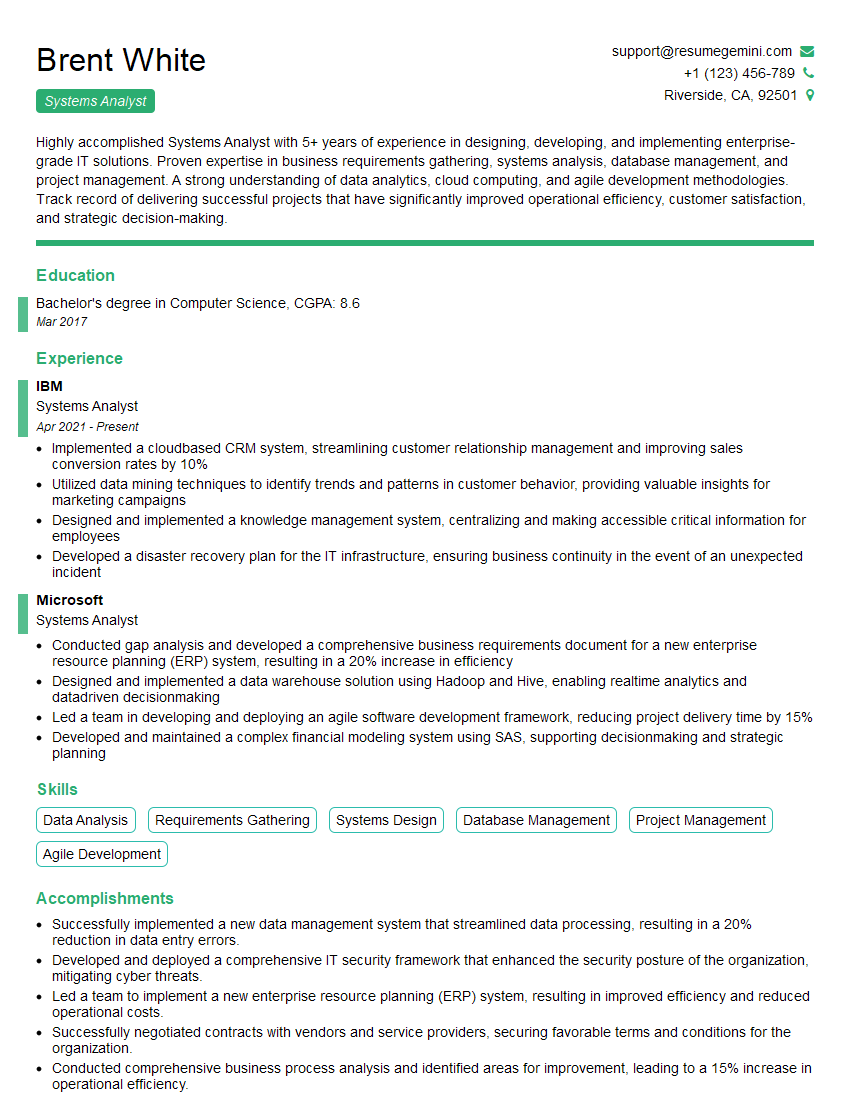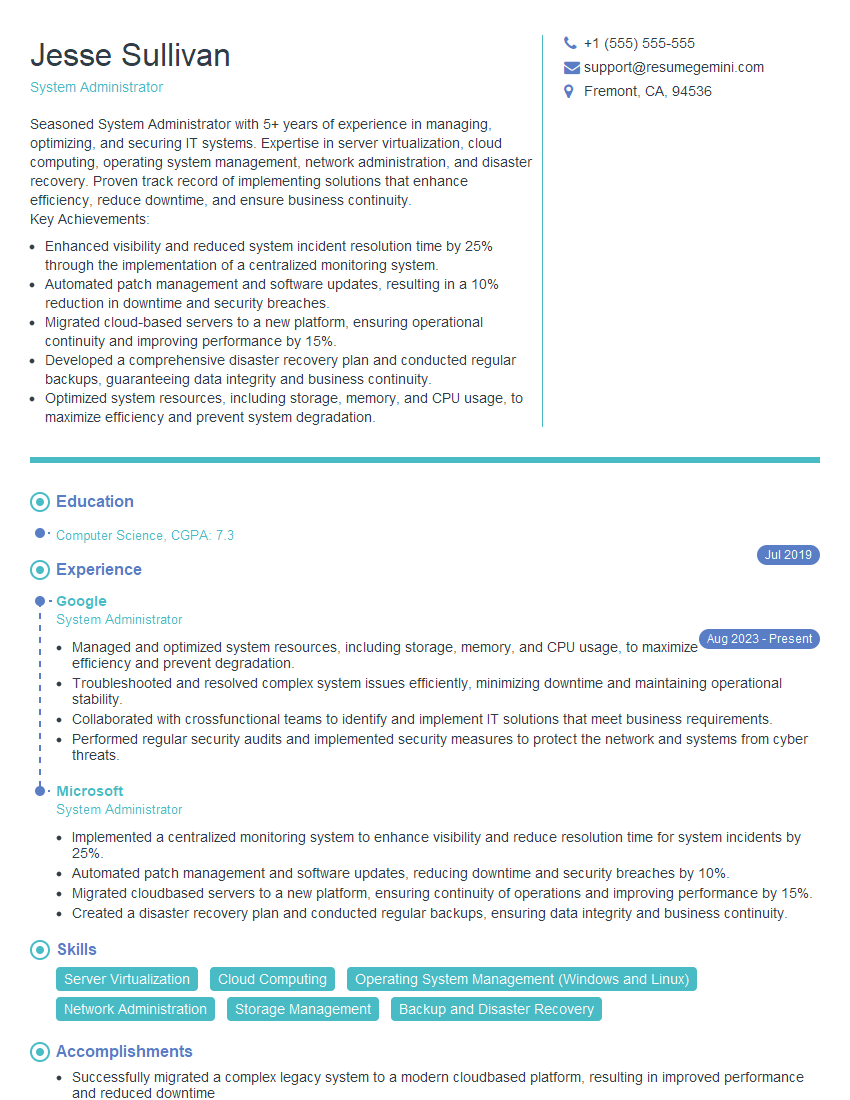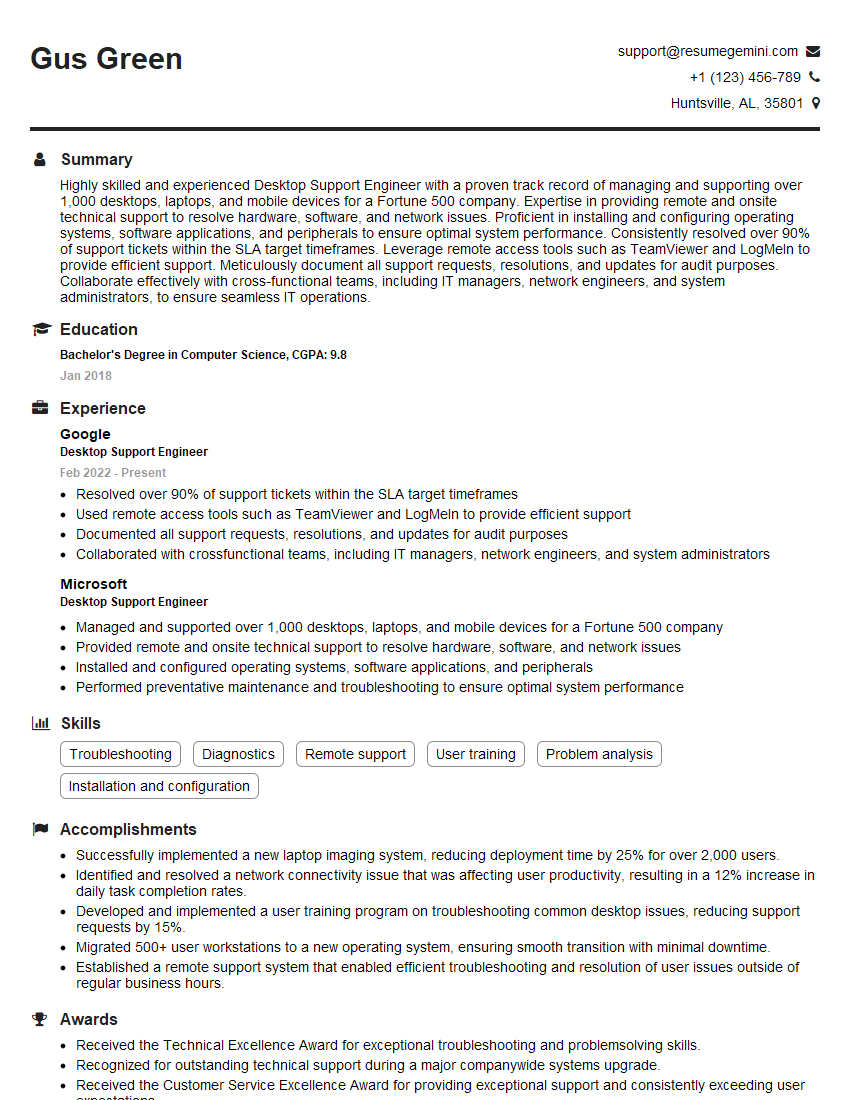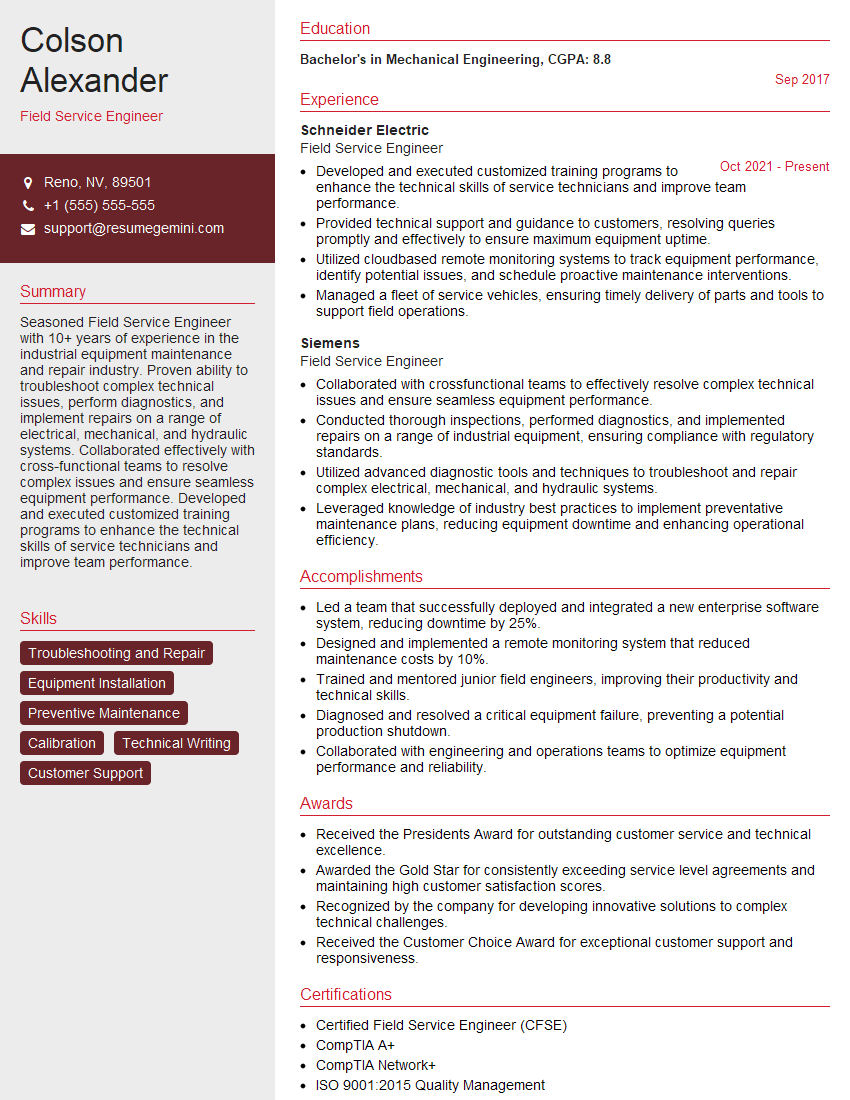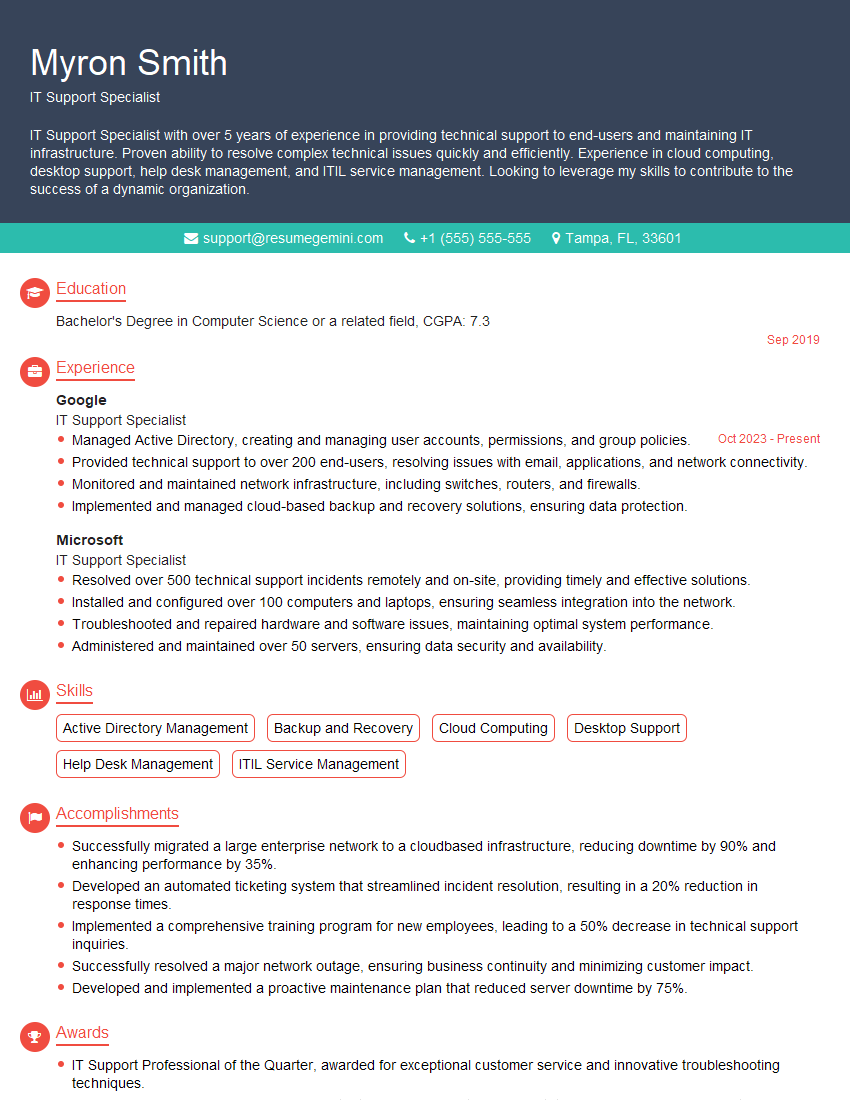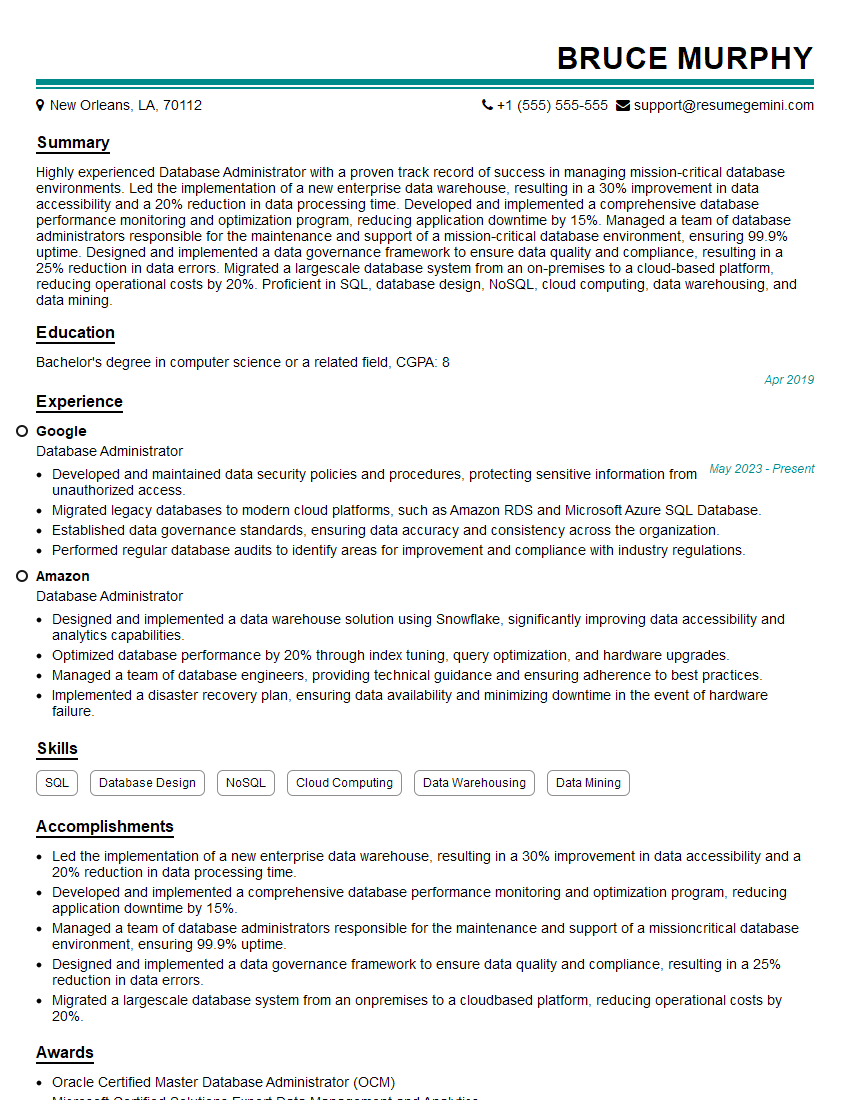Unlock your full potential by mastering the most common Application Support interview questions. This blog offers a deep dive into the critical topics, ensuring you’re not only prepared to answer but to excel. With these insights, you’ll approach your interview with clarity and confidence.
Questions Asked in Application Support Interview
Q 1. Explain your experience with incident management and escalation procedures.
Incident management is the process of identifying, analyzing, and resolving incidents that disrupt IT services. My experience involves handling incidents across a variety of applications, from simple user errors to complex system failures. Escalation procedures are critical for managing incidents that exceed a team’s capabilities.
In my previous role, we used a tiered escalation system. Level 1 support handled basic troubleshooting and user requests. If the issue couldn’t be resolved, it was escalated to Level 2, a team with more specialized skills. For critical incidents, or those impacting a large number of users, Level 3, which included senior engineers and architects, was involved. This involved clearly documenting the issue, its impact, and any initial troubleshooting steps in our ticketing system (ServiceNow, in this case). We followed pre-defined runbooks and communication protocols to ensure timely resolution and keep stakeholders informed.
For example, once, we experienced a sudden spike in database errors during peak hours. Level 1 tried basic fixes, but the problem persisted. Escalation to Level 2 pinpointed a memory leak in a specific application module. Level 3 then coordinated a temporary rollback to an earlier version while a permanent fix was developed and deployed, minimizing downtime and impact. Effective communication throughout the process was vital, ensuring transparency with users and management.
Q 2. Describe your troubleshooting methodology for application performance issues.
My troubleshooting methodology for application performance issues is systematic and data-driven. I utilize a multi-pronged approach encompassing various monitoring tools and techniques. Think of it like diagnosing a patient – we need to gather all the symptoms (metrics) before we can propose a treatment (solution).
I typically start by reviewing system logs, monitoring tools like Prometheus and Grafana (or equivalent) for slow response times, high CPU/memory utilization, or database bottlenecks. I then move towards application-specific performance monitoring using tools that provide insights into request processing times, error rates, and resource consumption.
Next, I examine network performance metrics to rule out network latency as a contributing factor. I might use tools like tcpdump or Wireshark to analyze network traffic. If the problem lies within the database, I’ll delve into query performance using database monitoring tools and query analysis techniques, potentially optimizing queries or database indexes.
For example, if an e-commerce website experiences slow loading times, I would first check server logs for errors, then look at CPU and memory usage, database query execution times, and network latency. The culprit might be anything from a poorly performing database query to a network bottleneck or a surge in user traffic. Identifying the bottleneck allows for targeted remediation and prevents inefficient troubleshooting.
Q 3. How do you prioritize multiple support requests simultaneously?
Prioritizing multiple support requests requires a structured approach. I use a combination of factors to determine urgency and impact. The most common method I use is a prioritization matrix based on urgency and impact. Urgency refers to how quickly the issue needs to be resolved, while impact measures the severity of the problem. Think of it as a 2×2 matrix: High Urgency/High Impact gets immediate attention, Low Urgency/Low Impact gets deferred.
My process involves carefully reviewing each ticket, assessing the urgency based on user impact (number of users affected, criticality of service), and the potential risk (data loss, security breach). I often use a ticketing system’s built-in features to categorize and tag requests by urgency and impact, ensuring a clear visual representation of the workload and helping to determine the order in which issues should be handled.
For instance, a system outage affecting all users would have higher priority than a single user’s password reset request. Utilizing a ticketing system allows for team collaboration, assignment of tasks, and tracking resolution progress effectively. Clear communication with users is crucial, keeping them informed of the status of their requests and estimated resolution times.
Q 4. What experience do you have with ticketing systems (e.g., Jira, ServiceNow)?
I have extensive experience with various ticketing systems, including Jira and ServiceNow. My proficiency extends beyond simply creating and closing tickets. I’m adept at using these systems to manage workflows, track progress, generate reports, and leverage their features for efficient support management. I understand the importance of using these systems effectively and know how to leverage their functionalities for reporting, automation, and team communication.
In my experience with Jira, I’ve used it for agile project management, integrating it with development processes. With ServiceNow, I’ve utilized its robust reporting and automation features for IT service management (ITSM) processes, including incident, problem, and change management. I’m comfortable configuring workflows, customizing dashboards, and using various integrations to streamline support operations. My familiarity also extends to using custom fields and workflows to tailor the systems to meet specific organizational needs.
For example, in a previous role, I customized a ServiceNow workflow to automatically escalate high-priority incidents to the appropriate team based on predefined criteria, significantly reducing resolution times. Proper use of these systems ensures clear communication, organized tracking, and efficient resource allocation.
Q 5. Describe your experience with database troubleshooting.
My database troubleshooting experience encompasses various aspects, from identifying performance bottlenecks to resolving data corruption and schema inconsistencies. I’m proficient in using SQL to query databases, analyze performance metrics, and troubleshoot issues. I’m familiar with various database systems including MySQL, PostgreSQL, and SQL Server, although my specific expertise may vary between them depending on the projects worked on.
My troubleshooting process typically begins with identifying the symptoms, such as slow query execution, high resource usage, or data inconsistencies. Then, I use database monitoring tools and performance analysis techniques to pinpoint the root cause. I might examine query execution plans to identify poorly performing queries, analyze server logs for errors, or check for disk space issues, and I might look at table fragmentation or index utilization.
For instance, I once resolved a significant performance issue in a MySQL database by optimizing a poorly written query. The original query used a full table scan, leading to significant performance degradation. By rewriting the query using appropriate indexes, we reduced query execution time by over 90%. Effective database troubleshooting requires a solid understanding of database internals, performance tuning techniques, and the ability to interpret error logs.
Q 6. Explain your knowledge of different operating systems (Windows, Linux, macOS).
I have experience working with Windows, Linux (various distributions like CentOS, Ubuntu), and macOS operating systems. My experience includes administering servers, troubleshooting system issues, and managing user accounts across these platforms. My understanding isn’t just limited to superficial knowledge; I possess a practical understanding of their underlying architecture, command-line interfaces, and system administration tools.
On Windows, I’m proficient in using PowerShell for automation and administration tasks, troubleshooting using Event Viewer, and managing services and processes. With Linux, I’m comfortable using the command line (Bash, Zsh), managing users and groups, monitoring system performance using tools like top and htop, and configuring system services (systemd). With macOS, I have experience managing user accounts, troubleshooting networking issues, and working with the command line interface (Bash).
For example, I’ve resolved numerous issues related to system resource exhaustion on Linux servers by using tools like top to identify processes consuming excessive CPU or memory resources. This often involves optimizing application configurations, identifying and resolving memory leaks, or adjusting system resources as needed. Understanding the nuances of each OS allows for effective problem-solving across various environments.
Q 7. How familiar are you with network troubleshooting techniques?
I’m familiar with a range of network troubleshooting techniques, from basic ping and traceroute commands to more advanced techniques such as packet capture and analysis. My approach is systematic and involves a combination of tools and techniques depending on the specific issue.
I start by gathering information from the user or system logs, identifying the affected services and their symptoms. I then use basic network diagnostic tools like ping and traceroute to check connectivity and identify potential points of failure along the network path. I also leverage network monitoring tools to assess network performance metrics, such as bandwidth utilization, packet loss, and latency.
For more complex issues, I utilize packet capture tools like Wireshark to analyze network traffic and identify specific problems, such as faulty network configurations, DNS resolution issues, or firewall restrictions. Understanding concepts like IP addressing, subnetting, routing protocols, and network topologies are crucial for effective troubleshooting.
For example, I once diagnosed a network connectivity issue by using Wireshark to identify that a firewall rule was blocking traffic to a specific port. This required close collaboration with the network team to adjust the firewall rule and restore connectivity. Effective network troubleshooting often involves a blend of technical skills and collaborative problem-solving.
Q 8. What are your preferred methods for documenting technical solutions?
Effective documentation is crucial for maintainable and supportable applications. My preferred methods involve a multi-faceted approach, combining different documentation styles to cater to various needs. I primarily utilize a wiki-based system (like Confluence or similar) for knowledge base articles, which allows for collaborative editing and version control. This is ideal for capturing troubleshooting steps, configuration details, and known issues. For more complex procedures or architectural overviews, I leverage diagramming tools like Lucidchart or draw.io to create visual representations that enhance understanding. Finally, I strongly believe in detailed logging within the application itself, allowing for easy tracing of events and debugging. This layered approach ensures that information is accessible to various team members, regardless of their technical expertise.
For instance, a recent project involved documenting the migration process to a new database server. The wiki contained detailed step-by-step instructions with screenshots. A Lucidchart diagram showed the network architecture and data flow, while the application logs provided valuable runtime information should issues arise during or after the migration.
Q 9. Describe a time you had to resolve a complex technical issue under pressure.
During a major system upgrade, our production environment experienced widespread outages just hours before a critical deadline. The root cause was a misconfiguration in the load balancer, leading to an uneven distribution of traffic and eventual server overload. Under immense pressure, I followed a structured approach. First, I engaged the team to isolate the impacted areas, quickly assessing the situation’s severity. Simultaneously, I began reviewing the load balancer configuration logs, identifying the problematic setting. While troubleshooting, I kept stakeholders informed with regular updates on progress and estimated resolution times, fostering transparency and managing expectations. I then initiated a rollback to the previous configuration as a temporary fix, ensuring service restoration. Finally, after restoring services, I carefully reconfigured the load balancer, thoroughly testing each step before pushing the changes live. Post-incident analysis helped us implement better monitoring and alerting systems to prevent future occurrences. This experience highlighted the importance of proactive monitoring, robust logging, and effective communication during crisis situations.
Q 10. How do you handle situations where you don’t know the answer to a user’s question?
When faced with an unfamiliar question, honesty and transparency are key. I never pretend to know something I don’t. Instead, I acknowledge the knowledge gap and outline a clear plan to find the answer. This usually involves these steps: 1) Carefully listen to the user to fully understand their problem. 2) Consult internal resources like the knowledge base, documentation, or past incident reports. 3) If internal resources are insufficient, leverage external resources like the application vendor’s support portal or online communities (while ensuring data privacy). 4) If necessary, involve senior colleagues or subject matter experts. 5) Keep the user informed about the progress and expected timeframe for resolution. It’s crucial to maintain open communication, updating the user on the progress and acknowledging any delays. This approach demonstrates professionalism and builds trust, even when immediate solutions aren’t available. I consider finding the right solution even more important than having all the immediate answers.
Q 11. What is your experience with remote support tools?
I have extensive experience with various remote support tools, including TeamViewer, AnyDesk, LogMeIn, and Microsoft Remote Desktop. My proficiency extends beyond basic remote access; I’m comfortable utilizing features like remote command execution, file transfer, and collaborative sessions. The choice of tool depends on the specific scenario – for example, TeamViewer’s ease of use makes it ideal for quick troubleshooting sessions with end-users, while LogMeIn’s more advanced features are better suited for managing server environments. Furthermore, I understand the security implications associated with remote access and always prioritize secure connections and adhere to company security policies.
Q 12. Explain your understanding of ITIL best practices.
ITIL (Information Technology Infrastructure Library) best practices provide a framework for managing IT services throughout their lifecycle. My understanding encompasses key areas like Incident Management (quickly restoring services), Problem Management (identifying root causes), Change Management (controlling modifications to minimize disruption), and Service Level Management (defining and meeting agreed-upon service levels). In practice, this means adhering to structured processes for handling incidents, prioritizing issues based on impact and urgency, implementing change control boards to review proposed changes, and consistently monitoring key performance indicators (KPIs) to ensure services are meeting expectations. For example, I’ve been instrumental in implementing a change management process that significantly reduced the number of unplanned outages in our environment by enforcing proper testing and approval procedures before any changes are deployed to production.
Q 13. How do you ensure application security and data integrity?
Ensuring application security and data integrity requires a multi-layered approach. This starts with secure coding practices, regularly updated software, and strong access controls, limiting user privileges to what’s absolutely necessary. We use vulnerability scanning tools to identify and address security flaws promptly. Regular security audits and penetration testing help identify and mitigate potential threats proactively. Data integrity is maintained through robust database backup and recovery mechanisms, regular data validation checks, and using encryption for sensitive data both at rest and in transit. Furthermore, adhering to relevant compliance regulations (like GDPR, HIPAA, etc.) is crucial, depending on the industry and data handled. For example, we use data masking techniques during testing to protect sensitive data and ensure compliance. A well-defined incident response plan ensures swift actions in case of breaches or security incidents, minimizing impact and facilitating a speedy recovery.
Q 14. What scripting languages are you proficient in (e.g., PowerShell, Bash) ?
I’m proficient in PowerShell and Bash scripting. PowerShell is my go-to for automating tasks within the Windows environment, particularly for managing Active Directory, servers, and applications. I’ve used it extensively to create scripts for automating user provisioning, software deployments, and system administration tasks. For example, I developed a PowerShell script to automate the process of creating new user accounts and assigning them appropriate permissions based on their roles. Bash scripting is primarily used for Linux/Unix-based systems, automating tasks like log analysis, system monitoring, and deployment processes. I’ve utilized it to create scripts for monitoring system resources, sending automated alerts, and deploying applications to our cloud infrastructure. My scripting skills significantly improve operational efficiency, reduce manual intervention, and improve consistency and accuracy in tasks.
Q 15. Describe your experience with monitoring tools (e.g., Nagios, Zabbix).
My experience with monitoring tools like Nagios and Zabbix is extensive. I’ve used them to proactively identify and resolve issues before they impact users. Think of them as the vital signs monitors for your applications. Nagios, for instance, is great for its plugin architecture, allowing for customization to monitor various aspects, from CPU usage and disk space to database performance and custom application metrics. I’ve used its alerting system extensively to trigger notifications via email or SMS when thresholds are breached. Zabbix, on the other hand, excels in its distributed monitoring capabilities and its robust auto-discovery features, simplifying the monitoring of large and complex infrastructures. In one project, we used Zabbix to monitor a geographically dispersed network of servers, proactively identifying and resolving network latency issues before they impacted user experience. I’m comfortable configuring, implementing, and maintaining these tools, ensuring timely alerts and detailed reporting for efficient troubleshooting.
For example, in a previous role, we used Nagios to monitor a critical e-commerce application. By setting alerts for high CPU usage, we were able to identify a memory leak before it caused a website crash during a peak sales period, preventing significant revenue loss.
Career Expert Tips:
- Ace those interviews! Prepare effectively by reviewing the Top 50 Most Common Interview Questions on ResumeGemini.
- Navigate your job search with confidence! Explore a wide range of Career Tips on ResumeGemini. Learn about common challenges and recommendations to overcome them.
- Craft the perfect resume! Master the Art of Resume Writing with ResumeGemini’s guide. Showcase your unique qualifications and achievements effectively.
- Don’t miss out on holiday savings! Build your dream resume with ResumeGemini’s ATS optimized templates.
Q 16. How do you contribute to a positive team environment in a high-pressure support role?
In high-pressure support roles, fostering a positive team environment is crucial for success. It’s about teamwork, open communication, and mutual respect. I believe in leading by example – maintaining a calm and professional demeanor, even under stress. This sets the tone for the team, encouraging them to do the same. I actively promote open communication through regular team meetings and daily stand-ups, ensuring everyone is informed and feels heard. We share knowledge and challenges openly, learning from each other’s experiences. I also actively celebrate successes, both big and small, to build morale and foster a sense of accomplishment.
For example, during a major service outage, instead of assigning blame, I focused on facilitating a collaborative problem-solving session. By acknowledging everyone’s contributions, we were able to restore service faster and build a stronger sense of camaraderie within the team.
Q 17. What is your experience with version control systems (e.g., Git)?
My experience with Git is extensive, encompassing all aspects of its use in a collaborative software development environment. I’m comfortable using Git for version control, branching strategies, merging, and resolving conflicts. I understand the importance of clean commit messages, meaningful branch names, and adhering to established workflows like Gitflow. I’ve used Git to manage code for both small and large projects, collaborating with developers across different geographical locations.
For instance, I’ve used Git’s branching feature extensively to manage feature development in parallel without impacting the main codebase. I’ve also used Git’s collaborative features to resolve merge conflicts efficiently, ensuring smooth code integration. I’m also proficient in using tools like GitHub and GitLab for code review and collaboration.
Q 18. Describe your experience with cloud platforms (e.g., AWS, Azure, GCP).
I have hands-on experience with several cloud platforms including AWS, Azure, and GCP. My experience spans various services, including compute (EC2, Azure VMs, Compute Engine), storage (S3, Azure Blob Storage, Cloud Storage), databases (RDS, Azure SQL Database, Cloud SQL), and networking (VPC, Virtual Networks, VPC Network). I understand the architectural considerations for designing and deploying applications in cloud environments, focusing on scalability, reliability, and security. I’m proficient in using cloud-native tools for monitoring, logging, and automation. I can effectively troubleshoot issues related to cloud infrastructure and application deployments.
In a recent project, I migrated a legacy on-premise application to AWS, leveraging services like EC2, S3, and RDS. This involved careful planning, migration, and testing to ensure a smooth transition with minimal downtime.
Q 19. How do you stay up-to-date with the latest technologies and industry trends?
Staying up-to-date with the latest technologies and industry trends is a continuous process. I actively participate in online courses and webinars, focusing on areas relevant to my role. I follow industry blogs, publications, and podcasts to stay informed about emerging technologies and best practices. I also attend conferences and workshops whenever possible to network with other professionals and learn from their experiences. I actively contribute to online communities, engaging in discussions and sharing my knowledge with others. This helps me stay abreast of changes and advancements in the field.
For instance, I recently completed a course on Kubernetes, enabling me to better understand and support containerized applications deployed in the cloud.
Q 20. What is your experience with disaster recovery and business continuity planning?
My experience with disaster recovery (DR) and business continuity planning (BCP) involves developing and implementing strategies to minimize the impact of disruptions. This includes identifying critical systems and data, defining recovery time objectives (RTOs) and recovery point objectives (RPOs), and developing detailed recovery plans. I’ve worked with various DR techniques, including backups, replication, and failover mechanisms. I’m familiar with different DR architectures, including hot, warm, and cold sites. I’ve participated in DR drills and exercises, ensuring the effectiveness of the plans and identifying areas for improvement.
In a previous role, I was involved in developing a BCP for a financial institution. This involved identifying critical business functions, developing recovery strategies, and establishing communication protocols to ensure business continuity in the event of a disaster.
Q 21. How do you handle user complaints and difficult situations?
Handling user complaints and difficult situations requires empathy, patience, and strong communication skills. My approach is to listen actively to the user’s concerns, acknowledging their frustration and validating their feelings. I strive to understand the root cause of the problem, rather than just focusing on the symptoms. I clearly explain the steps I’m taking to resolve the issue, setting realistic expectations about the timeframe for resolution. If immediate resolution isn’t possible, I keep the user updated on my progress. I strive to resolve issues professionally and efficiently, building a positive user experience even in challenging situations.
For example, when faced with an angry customer, I calmly listened to their concerns, empathized with their frustration, and then systematically worked towards resolving their issue. This approach often diffused their anger, turning a negative experience into a positive one.
Q 22. Describe your experience with performance tuning and optimization.
Performance tuning and optimization is the process of improving the speed, efficiency, and responsiveness of an application. It involves identifying bottlenecks and inefficiencies, and then implementing solutions to address them. This often requires a deep understanding of the application’s architecture, codebase, and underlying infrastructure.
In my previous role, we experienced significant slowdowns in our e-commerce platform during peak shopping seasons. Through performance profiling tools, we identified a database query that was taking an excessively long time to execute. We optimized this query by adding indexes and rewriting parts of the SQL code, resulting in a 70% reduction in processing time. Another example involved optimizing images used on the website. By compressing images without significant loss of quality, we reduced page load times and improved user experience significantly. We also utilized caching mechanisms to store frequently accessed data, reducing the load on the database and application servers. This involved implementing a robust caching strategy using Redis, which improved response times by approximately 40%. Finally, load testing was integral. We used JMeter to simulate heavy user traffic and identify potential bottlenecks *before* they impacted real users. This proactive approach allowed for effective mitigation strategies.
Q 23. Explain your understanding of different application architectures.
Understanding different application architectures is crucial for effective application support. Different architectures have varying strengths and weaknesses, impacting scalability, maintainability, and security.
- Monolithic Architecture: This is a traditional approach where all components of the application are tightly coupled and deployed as a single unit. While simpler to develop and deploy initially, scaling and maintenance can become challenging as the application grows. Think of a traditional desktop application – everything is bundled together.
- Microservices Architecture: This breaks down the application into smaller, independent services that communicate with each other. Each service can be developed, deployed, and scaled independently. This offers greater flexibility and scalability, but requires more complex orchestration and monitoring. Imagine building with LEGOs – each brick is a service, and you can easily replace or add bricks without affecting the entire structure.
- Serverless Architecture: This architecture relies on cloud providers to manage the underlying infrastructure. Code is executed in response to events, eliminating the need to manage servers. This is highly scalable and cost-effective but requires careful consideration of vendor lock-in and potential cold starts.
- Client-Server Architecture: A classic model where a client (like a web browser) requests data or services from a server. This is a fundamental structure used in many applications, forming the basis of many other architectures.
My experience spans across all these architectures, allowing me to effectively troubleshoot and support applications built using various technologies and design patterns.
Q 24. What is your experience with capacity planning and resource management?
Capacity planning and resource management are essential for ensuring application performance and availability. It involves forecasting future resource needs based on current usage trends and projected growth. This helps prevent performance bottlenecks and ensures sufficient resources are available to handle peak loads.
I’ve used various techniques for capacity planning, including historical data analysis, trend forecasting, and load testing. For example, in a previous role, we used historical data from the past year to predict future database storage needs. This allowed us to proactively increase storage capacity before we ran out of space. We also employed load testing tools like JMeter to simulate future traffic patterns and identify potential resource constraints. Based on the results, we adjusted our server infrastructure to ensure sufficient resources were available during peak traffic periods. This proactive approach helped avoid performance degradation and service disruptions.
Resource management involves efficiently allocating and utilizing available resources. This includes monitoring CPU, memory, disk I/O, and network usage to identify and address performance bottlenecks. Tools like CloudWatch (AWS) and Datadog are crucial for this task. Effective resource management is key to optimizing costs and maintaining high application performance.
Q 25. How do you balance the need for quick resolution with thorough problem analysis?
Balancing quick resolution with thorough problem analysis is a key skill in application support. While immediate fixes are important to minimize downtime, a rush to a solution without a full understanding of the root cause can lead to recurring issues. I use a structured approach:
- Immediate Response: First, I prioritize actions to mitigate the immediate impact of the issue. This might involve restarting a service, rolling back a deployment, or implementing a temporary workaround.
- Problem Diagnosis: Next, I conduct a thorough investigation to pinpoint the root cause. This includes gathering relevant logs, monitoring system metrics, and analyzing application traces. Tools like Splunk or ELK stack are invaluable here.
- Solution Implementation: Once the root cause is identified, I implement a permanent fix that addresses the underlying problem. This might involve code changes, configuration updates, or infrastructure modifications.
- Testing and Validation: Before deploying the fix, I thoroughly test it to ensure it resolves the issue without introducing new problems.
- Documentation and Prevention: Finally, I document the issue, the root cause, and the solution to prevent similar problems in the future. This might involve adding monitoring alerts or updating runbooks.
This approach allows for rapid initial response while ensuring long-term stability and preventing future occurrences of similar incidents.
Q 26. Describe your experience with automation and scripting to improve support processes.
Automation and scripting are essential for improving application support efficiency and reducing manual intervention. This can range from simple shell scripts to complex automation workflows using tools like Ansible, Chef, or Puppet.
I have extensive experience in automating repetitive tasks, such as server provisioning, software deployment, and log analysis. For example, I created a Python script that automatically analyzes application logs for specific error patterns and generates alerts when issues are detected. This reduced the time spent manually reviewing logs and allowed for faster issue resolution. Another example involved automating the deployment process using Ansible. This eliminated manual steps and ensured consistent deployments across various environments. In addition, I’ve used scripting to create self-service tools for common support requests, reducing the number of support tickets and empowering end-users to resolve issues independently. Automating tasks reduces human error, frees up time for more complex issues, and ultimately improves overall efficiency.
Q 27. What metrics do you use to measure the effectiveness of application support?
Measuring the effectiveness of application support relies on several key metrics. These metrics help to gauge performance, identify areas for improvement, and demonstrate the value of the support team.
- Mean Time To Resolution (MTTR): The average time it takes to resolve an incident. A lower MTTR indicates better efficiency.
- Mean Time To Acknowledgement (MTTA): The average time it takes to acknowledge a reported incident. A low MTTA shows responsiveness.
- Service Level Agreement (SLA) Compliance: The percentage of incidents resolved within agreed-upon service level targets.
- Customer Satisfaction (CSAT): Measures how satisfied users are with the support provided. Often gathered through surveys or feedback forms.
- Incident Volume: The number of reported incidents. A decrease suggests improved application stability.
- Number of Open Tickets: Tracks the backlog of unresolved issues.
- Uptime/Availability: The percentage of time the application is operational.
Tracking these metrics provides a comprehensive view of application support effectiveness. Regular monitoring and analysis of these metrics are crucial for identifying trends and implementing necessary improvements.
Q 28. How familiar are you with different types of application logs and how to interpret them?
Familiarity with different types of application logs is critical for effective troubleshooting. Logs provide valuable insights into the application’s behavior, performance, and errors.
I’m experienced in working with various log types, including:
- System Logs: These logs record system events, such as boot processes, resource usage, and security events. Examples include Windows Event Logs and Linux syslog.
- Application Logs: These logs record events specific to the application, such as errors, warnings, and informational messages. The format varies widely depending on the application and logging framework used (e.g., log4j, Serilog).
- Database Logs: These logs record database operations, including queries, transactions, and errors. Understanding database logs is essential for debugging database-related issues.
- Web Server Logs: These logs record website traffic, including requests, responses, and errors. Apache and Nginx logs are common examples.
Interpreting logs requires understanding the log format and identifying relevant information, such as timestamps, error codes, and stack traces. Tools like the ELK stack (Elasticsearch, Logstash, Kibana) or Splunk facilitate log aggregation, analysis, and visualization, making it easier to identify patterns and pinpoint the root cause of problems. My expertise includes using regular expressions (regex) to search for specific patterns within logs and utilizing various log analysis tools to efficiently analyze large log files.
Key Topics to Learn for Application Support Interview
- Incident Management: Understanding incident lifecycle, prioritization, and resolution techniques. Practical application: Describe your experience troubleshooting software issues and escalating when necessary.
- Problem Management: Identifying root causes of recurring incidents and implementing preventative measures. Practical application: Explain a situation where you identified a recurring problem and implemented a solution to prevent future occurrences.
- Request Fulfillment: Managing and fulfilling user requests for software access, account modifications, and other services. Practical application: Detail your experience handling user requests efficiently and effectively.
- Change Management: Understanding the change management process, including risk assessment and impact analysis. Practical application: Describe your involvement in implementing changes to applications and systems.
- ITIL Framework: Familiarity with the key principles and processes of ITIL, especially as they relate to application support. Practical application: Explain how ITIL principles have guided your approach to application support tasks.
- Database Fundamentals: Basic understanding of database concepts (SQL, relational databases) and how they relate to application functionality. Practical application: Describe how you’ve used database knowledge to troubleshoot application issues.
- Operating Systems & Networking: Foundational knowledge of common operating systems (Windows, Linux) and networking concepts. Practical application: Explain how understanding of OS and networking helped resolve an application issue.
- Troubleshooting & Diagnostics: Developing effective troubleshooting strategies and using diagnostic tools to identify and resolve application issues. Practical application: Describe your systematic approach to troubleshooting complex application problems.
Next Steps
Mastering Application Support opens doors to a rewarding career with excellent growth potential, offering opportunities for specialization and increased responsibility. To significantly boost your job prospects, creating a strong, ATS-friendly resume is crucial. ResumeGemini is a trusted resource that can help you build a professional and impactful resume tailored to the specific requirements of Application Support roles. Examples of resumes optimized for Application Support positions are available to guide you.
Explore more articles
Users Rating of Our Blogs
Share Your Experience
We value your feedback! Please rate our content and share your thoughts (optional).
What Readers Say About Our Blog
Hi, I’m Jay, we have a few potential clients that are interested in your services, thought you might be a good fit. I’d love to talk about the details, when do you have time to talk?
Best,
Jay
Founder | CEO
